|
GeoSciences e-Journals are back!
|
|
|
|

|
|
2025 (vol. 26)
|
|
Elusive Golden Spikes: When stratigraphers face the technical impossibility of specifying a GSSP in the field
Bruno R.C. GRANIER
| HTML  | PDF
| PDF  [3,188 KB]
| DOI: 10.2110/carnets.2026.2601 [3,188 KB]
| DOI: 10.2110/carnets.2026.2601
|
|
 Abstract: This publication explores challenges in defining Global Boundary Stratotype Sections
and Points (GSSPs) and Standard Auxiliary Boundary Stratotypes (SABSs). It
identifies issues with recent practices that undermine the principles of
uniqueness and accessibility fundamental to these boundaries. Examples include
the controversial use of cores to designate GSSPs for the Quaternary Period, the
disregard for essential geological requirements, the failure to ensure field
accessibility, and the lack of protection for key sites. These concerns,
exemplified by the Cenomanian GSSP for the Cretaceous Period, which remains
unprotected after more than 20 years, highlight the need for stricter adherence
to guidelines and a reevaluation of current practices, advocating for the
mandatory enforcement of certain rules. Other examples discussed specifically
relate to the author's personal experience with Lower Cretaceous GSSPs and SABSs. Abstract: This publication explores challenges in defining Global Boundary Stratotype Sections
and Points (GSSPs) and Standard Auxiliary Boundary Stratotypes (SABSs). It
identifies issues with recent practices that undermine the principles of
uniqueness and accessibility fundamental to these boundaries. Examples include
the controversial use of cores to designate GSSPs for the Quaternary Period, the
disregard for essential geological requirements, the failure to ensure field
accessibility, and the lack of protection for key sites. These concerns,
exemplified by the Cenomanian GSSP for the Cretaceous Period, which remains
unprotected after more than 20 years, highlight the need for stricter adherence
to guidelines and a reevaluation of current practices, advocating for the
mandatory enforcement of certain rules. Other examples discussed specifically
relate to the author's personal experience with Lower Cretaceous GSSPs and SABSs.
|
|
Carnets Geol., vol. 26, no. 1, p. 1-16
Online since December 1, 2025
|

|
|
2025 (vol. 25)
|
|
Preliminary investigations of an Aptian GSSP candidate at the historical Bedoulian locality near Cassis (Bouches-du-Rhône) and a complementary section at the stratotype Barremian locality at Angles (Alpes-de-Haute-Provence)
Didier BERT, Stéphane BERSAC & Yves DUTOUR
| HTML  | PDF
| PDF  [1,136 KB]
| DOI: 10.2110/carnets.2025.2515 [1,136 KB]
| DOI: 10.2110/carnets.2025.2515
|
|
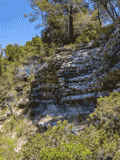 Abstract: This report presents preliminary investigations of a new candidate for the
Aptian Global boundary Stratotype Section and Point (GSSP) at Cassis (Bouches-du-Rhône, France), within the historical Bedoulian stratotype area,
and a complementary section at Angles (Alpes-de-Haute-Provence, France).
Fieldwork in 2025 identified a promising continuous section (13022-BGD) in the
Vallat des Brayes–Brigadan area of Cassis, exposing the lower Aptian La Bédoule
Formation. Preliminary observations of Pseudocrioceras and Deshayesites
indicate that the Barremian/Aptian boundary likely occurs within a narrow
interval. Despite partial coverage, the section is accessible, correlatable,
and located on protected municipal land, making it a strong GSSP candidate.
Complementary research at Angles confirms comparable faunal successions in a
pelagic context, notably at the Combe-Lambert section, now fully exposed and
protected within the National Geological Nature Reserve. Together, these sites
provide an integrated framework for defining the base of the Aptian Stage. Abstract: This report presents preliminary investigations of a new candidate for the
Aptian Global boundary Stratotype Section and Point (GSSP) at Cassis (Bouches-du-Rhône, France), within the historical Bedoulian stratotype area,
and a complementary section at Angles (Alpes-de-Haute-Provence, France).
Fieldwork in 2025 identified a promising continuous section (13022-BGD) in the
Vallat des Brayes–Brigadan area of Cassis, exposing the lower Aptian La Bédoule
Formation. Preliminary observations of Pseudocrioceras and Deshayesites
indicate that the Barremian/Aptian boundary likely occurs within a narrow
interval. Despite partial coverage, the section is accessible, correlatable,
and located on protected municipal land, making it a strong GSSP candidate.
Complementary research at Angles confirms comparable faunal successions in a
pelagic context, notably at the Combe-Lambert section, now fully exposed and
protected within the National Geological Nature Reserve. Together, these sites
provide an integrated framework for defining the base of the Aptian Stage.
|
|
Carnets Geol., vol. 25, no. 15, p. 307-317
Online since November 11, 2025
|
|
Gusicella Schlagintweit & Rashidi, 2021 (type species Dictyoconella minima Henson, 1948), Upper Cretaceous Larger Benthic Foraminifer and its species
Felix SCHLAGINTWEIT, Vicent VICEDO, Koorosh RASHIDI, Gianluca FRIJIA & Lorenzo CONSORTI
| HTML  | PDF
| PDF  [2,872 KB]
| DOI: 10.2110/carnets.2025.2514 [2,872 KB]
| DOI: 10.2110/carnets.2025.2514
|
|
 Abstract: Based on new
material from the middle to upper Cenomanian Natih Formation (members A and B)
from Oman, the little-known species Gusicella
minima (Henson), originally described from the Mishrif Formation of
Qatar (Dukhan wells) is redescribed. Late Maastrichtian specimens from the
Tarbur Formation of SW Iran previously assigned to the Cenomanian species
display a more complex marginal zone and are therefore introduced as Gusicella
complexa Schlagintweit & Rashidi sp. nov. Representatives
of Gusicella have so far only been reported from the Arabian Plate,
showing its endemic character. There is no record of the genus so far from the
Turonian to early Maastrichtian interval. Abstract: Based on new
material from the middle to upper Cenomanian Natih Formation (members A and B)
from Oman, the little-known species Gusicella
minima (Henson), originally described from the Mishrif Formation of
Qatar (Dukhan wells) is redescribed. Late Maastrichtian specimens from the
Tarbur Formation of SW Iran previously assigned to the Cenomanian species
display a more complex marginal zone and are therefore introduced as Gusicella
complexa Schlagintweit & Rashidi sp. nov. Representatives
of Gusicella have so far only been reported from the Arabian Plate,
showing its endemic character. There is no record of the genus so far from the
Turonian to early Maastrichtian interval.
|
|
Carnets Geol., vol. 25, no. 14, p. 283-305
Online since November 7, 2025
|
|
Terrapin aches and pains: Parasite borings and other bone modifications in an Italian Pliocene population of Mauremys (Testudines, Geoemydidae)
Federica MULÈ, Simone CASATI, Luca BONFIGLI, Andrea DI CENCIO & Alberto COLLARETA
| HTML  | PDF
| PDF  [1,531 KB]
| DOI: 10.2110/carnets.2025.2513 [1,531 KB]
| DOI: 10.2110/carnets.2025.2513
|
|
 Abstract: Despite
the common and widespread occurrence of turtle shell remains in many fossil
vertebrate assemblages worldwide, few palaeontological studies have addressed
the palaeoecological significance of turtle bone modification features. Here, we
report on ichnofossils occurring on carapacial and plastral bones of the small
terrapin genus Mauremys (Testudinoidea, Geoemydidae) from Upper Pliocene
deposits exposed at La Serra, in the Valdelsa basin of Tuscany (central Italy).
The trace fossil assemblage includes Karethraichnus lakkos, Gunnellichnus
cf. moghraensis, and Thatchtelithichnus holmani, all of which
are found on the nonvisceral surfaces of the shell. As observed elsewhere, some
of the Karethraichnus lakkos borings occur along the epidermal sulci
that mark the border between adjacent keratinous scutes. Based on the relevant
literature, the studied ichnofossils are interpreted as being due to the
parasitic action of leeches/spirorchiid liver flukes (K. lakkos and Thatchtelithichnus
holmani) and to algal/fungal/bacterial (sub)cutaneous infections (Gunnellichnus
cf. moghraensis). The observed stock of
bioerosional features compares favourably with the Italian Pliocene climate,
which was warmer and wetter than today. Abstract: Despite
the common and widespread occurrence of turtle shell remains in many fossil
vertebrate assemblages worldwide, few palaeontological studies have addressed
the palaeoecological significance of turtle bone modification features. Here, we
report on ichnofossils occurring on carapacial and plastral bones of the small
terrapin genus Mauremys (Testudinoidea, Geoemydidae) from Upper Pliocene
deposits exposed at La Serra, in the Valdelsa basin of Tuscany (central Italy).
The trace fossil assemblage includes Karethraichnus lakkos, Gunnellichnus
cf. moghraensis, and Thatchtelithichnus holmani, all of which
are found on the nonvisceral surfaces of the shell. As observed elsewhere, some
of the Karethraichnus lakkos borings occur along the epidermal sulci
that mark the border between adjacent keratinous scutes. Based on the relevant
literature, the studied ichnofossils are interpreted as being due to the
parasitic action of leeches/spirorchiid liver flukes (K. lakkos and Thatchtelithichnus
holmani) and to algal/fungal/bacterial (sub)cutaneous infections (Gunnellichnus
cf. moghraensis). The observed stock of
bioerosional features compares favourably with the Italian Pliocene climate,
which was warmer and wetter than today.
|
|
Carnets Geol., vol. 25, no. 13, p. 265-281
Online since November 4, 2025
|
|
Reinterpretation of "Palaeodasycladus" (Chlorophyta, Dasycladales) from the Lower Jurassic of the Tatra Mountains, Poland
Filippo BARATTOLO & Ioan I. BUCUR
| HTML  | PDF
| PDF  [1,119 KB]
| DOI: 10.2110/carnets.2025.2512 [1,119 KB]
| DOI: 10.2110/carnets.2025.2512
|
|
 Abstract: The green alga Palaeodasycladus
(Pia, 1920) was recognized in shallow marine, high-energy calcarenites
from the Lower Jurassic Choč Nappe (Hronicum domain) in the Tatra Mountains of
Poland. The algal structure is described here. The calcareous skeleton has a
regular internal cavity, probably close to the central axis, but very irregular
outwardly, enveloping the primary laterals at different lengths. The general
shape of the thallus is spherical, with only long, acrophorous primary laterals,
probably forming a distal cortex. The external gametophores are attached
laterally to the primary laterals. The characteristics allow the alga to be
assigned not to Palaeodasycladus (Pia, 1920) but to Goniolina
Orbigny, 1850. Abstract: The green alga Palaeodasycladus
(Pia, 1920) was recognized in shallow marine, high-energy calcarenites
from the Lower Jurassic Choč Nappe (Hronicum domain) in the Tatra Mountains of
Poland. The algal structure is described here. The calcareous skeleton has a
regular internal cavity, probably close to the central axis, but very irregular
outwardly, enveloping the primary laterals at different lengths. The general
shape of the thallus is spherical, with only long, acrophorous primary laterals,
probably forming a distal cortex. The external gametophores are attached
laterally to the primary laterals. The characteristics allow the alga to be
assigned not to Palaeodasycladus (Pia, 1920) but to Goniolina
Orbigny, 1850.
The new species Goniolina tatrarum n.sp. is here established. A critical review of the genus Goniolina
Orbigny, 1850, and its type species is also provided. The genus Goniolina Orbigny
appears to have been represented so far solely by G. hexagona Orbigny, 1850. G. geometrica Buvignier,
1852, and G. micraster Buvignier, 1852,
are considered valid and separate species to be assigned to Coniporella Fisher
& Thierry, 1971.
Sphaerites regularis Quenstedt, 1852, a supposed junior synonym of Goniolina geometrica
(Roemer, 1839), is provisionally assigned to the genus Tersella
J. Morellet in J. Morellet & Ters,
1952, and indicated as Tersella
(?) regularis (Quenstedt, 1852).
|
|
Carnets Geol., vol. 25, no. 12, p. 255-264
Online since October 31, 2025
|
|
The peri-Alpine Paleogene Red Molasse of southeastern France - I. Esparron syncline and Esclangon area (Alpes-de-Haute-Provence)
Serge FERRY, Philippe SORREL, Philippe GRANDJEAN & Sylvain AUGIER
| HTML  | PDF
| PDF  [8,448 KB]
| DOI: 10.2110/carnets.2025.2511 [8,448 KB]
| DOI: 10.2110/carnets.2025.2511
|
|
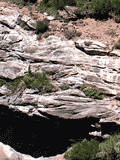 Abstract: The Paleogene succession of the Esparron syncline consists of three superimposed stratigraphic units, in ascending order: (1) a lacustrine-palustrine-dominated basal unit (BU) bearing channels filled by limestone breccias at base, (2) fluvial deposits of the lower Molasse Rouge Formation (MR1), and (3) well-rounded polygenic conglomerates, bearing Alpine "green rocks" and radiolarites overlain by red clays in the upper Molasse Rouge Formation (MR2). Abstract: The Paleogene succession of the Esparron syncline consists of three superimposed stratigraphic units, in ascending order: (1) a lacustrine-palustrine-dominated basal unit (BU) bearing channels filled by limestone breccias at base, (2) fluvial deposits of the lower Molasse Rouge Formation (MR1), and (3) well-rounded polygenic conglomerates, bearing Alpine "green rocks" and radiolarites overlain by red clays in the upper Molasse Rouge Formation (MR2).
Breccia deposits of the basal unit represent a multi-channeled torrential system generally sloping to the northeast. However, the regional extent and character of the BU is difficult to determine due to its truncation by the basal surface of MR1. Around the northwestern termination of the Esparron syncline the succession is complete and 200 m thick. Basal breccias of the BU pass upward to reddish fluvial overbank mudstones, then to grayish lacustrine-palustrine limestones, and back to reddish silty claystones. Field data suggest that this unit cannot be proximal deposits of the "Nummulitic foreland basin", but is younger, just predating deposition of the MR1, likely in the late Rupelian. These also cannot be proximal deposits of MR1, as formerly suggested. They constitute a fully distinct tectono-stratigraphic sequence whose deposition cannot be understood without a broad regional synthesis (in
preparation).
Along the southern flank of the syncline, MR1 has a sheet geometry featuring amalgamated fluvial point bar deposits at the base, which are overlain by the deposits of a large fluvial fan prograding to the west. MR1 deposits abruptly pinch out along the northern flank of the syncline, and are interpreted as having filled a paleovalley that roughly matches the E-W orientation of the
syncline.
South of the syncline, in the Esclangon and Hautes Duyes areas, the same succession is found but the meandering fluvial deposits of Esparron are lacking at the base of MR1. Here, MR1 deposits are represented by fluvial fan deposits prograding to the west, but have a more proximal character than at Esparron. In this area, the MR1unit is capped by the Molasse Grise (MG), which represents a flattening of the depositional profile after the progradation of the underlying fluvial fan.
Across the entire region, MR2 deposits are thin, and likely truncated by the main Digne thrust. They are deposited disconformably on top of either MR1 or directly on folded Mesozoic deposits, suggesting that erosion and tectonic activity occurred between deposition of MR1 and MR2. The occurrence of well-rounded pebbles of Alpine "green rocks" and radiolarites in the basal fluvial conglomerate of MR2 indicates that the system had a large watershed that encroached the inner Alps, probably during uplift of the latter.
In the Ainac area, the braided fluvial facies at the base of MR2 acquired a more distal character with channels filled by either conglomerates or a more sand-prone facies.
The vertical facies trend in MR1 and MR2 suggests that a low-gradient fluvial setting was followed by regional uplift responsible for the progradation of fluvial fans. The two stratigraphic units are therefore regarded as tectono-stratigraphic sequences, in response to changes in the Alpine stress regime. With unit 1 (BU), the Molasse Rouge is therefore composed of three independent
sequences.
Finally, the ages of the MR1 and MR2 deposits are revised, both to Chattian and probably not extending into the Aquitanian, as previously reported for the MR2.
Geometric relationships suggest that the three continental Paleogene sequences record a changing depositional setting controlled by both active tectonics and intervening periods of quiescence in a time interval grossly bracketing the late Rupelian and the
Chattian.
|
|
Carnets Geol., vol. 25, no. 11, p. 219-253
Online since October 17, 2025
|
|
Lower and lower Middle Jurassic foraminiferal assemblages and calcareous algae from the southern margin of the Central High Atlas, Morocco
Mohammed ETTAKI, Mohammed-Saïd BOUAOUDA, Michel SEPTFONTAINE, El Hassane CHELLAI, Abdallah MILHI, Radouan EL BAMIKI & Valery J. VUKS
| HTML  | PDF
| PDF  [2,781 KB]
| DOI: 10.2110/carnets.2025.2510 [2,781 KB]
| DOI: 10.2110/carnets.2025.2510
|
|
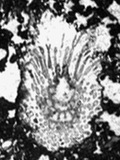 Abstract: The Lower and lower Middle Jurassic carbonates from the southern margin
of the Moroccan High Atlas yielded well-preserved foraminifers and calcareous
algae. The identification of these microfossils,
based on thin-section observations, allowed us to define seven
successive micropaleontological assemblages with ages from the early Sinemurian
to the early Bajocian. These micropaleontological assemblages, relatively well
calibrated by ammonites and brachiopods, were compared with the larger
foraminiferal biozonation of Septfontaine (1984)
for the Moroccan Tethys domain. A new biozone with Palaeodasycladus
mediterraneus is introduced to characterize the upper Pliensbachian (Algovianum
Zone) to lower Toarcian interval. Abstract: The Lower and lower Middle Jurassic carbonates from the southern margin
of the Moroccan High Atlas yielded well-preserved foraminifers and calcareous
algae. The identification of these microfossils,
based on thin-section observations, allowed us to define seven
successive micropaleontological assemblages with ages from the early Sinemurian
to the early Bajocian. These micropaleontological assemblages, relatively well
calibrated by ammonites and brachiopods, were compared with the larger
foraminiferal biozonation of Septfontaine (1984)
for the Moroccan Tethys domain. A new biozone with Palaeodasycladus
mediterraneus is introduced to characterize the upper Pliensbachian (Algovianum
Zone) to lower Toarcian interval.
|
|
Carnets Geol., vol. 25, no. 10, p. 201-217
Online since October 14, 2025
|
|
The Deshayesitidae (Ammonoidea, Ancyloceratina) in the lower Aptian (Lower Cretaceous) of the Les Ferres Aptian Basin (southeastern France)
Stéphane BERSAC & Didier BERT
| HTML  | PDF
| PDF  [2,818 KB]
| DOI: 10.2110/carnets.2025.2509 [2,818 KB]
| DOI: 10.2110/carnets.2025.2509
|
|
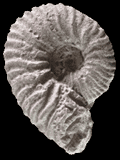 Abstract: In the present work, we study 335 specimens of Deshayesitidae (Ammonoidea) from
the vicinity of the village of Les Ferres (SE France). The Deshayesitidae is the
current key family for the ammonite biostratigraphy of the lower Aptian (Lower
Cretaceous). Despite poorly preserved, the studied material could have been
identified at species rank in most cases and allowed establishing the
biostratigraphic frame of the lower Aptian of the study area. The results are as
follows: (1) the studied samples range from the Deshayesites forbesi Zone
to the Dufrenoyia furcata Zone; (2) their ontogenetic sequence is
described; (3) their evolutionary patterns are consistent with those observed in
other samples of Deshayesitidae; (4) no dimorphism is conspicuous; (5) the
identified taxa are, from earliest to latest: Deshayesites sp. (Deshayesites
forbesi Zone, rounded ventral area probably without smooth siphonal band), Deshayesites
multicostatus Swinnerton, 1935 (index of subzone, intermediate smooth
siphonal band then rounded ventral area), Deshayesites grandis Spath, 1930 (index of subzone, longer smooth siphonal band then subtabulate ventral
area on phragmocone), Dufrenoyia furcata (J. de C. Sowerby, 1836)
(index of subzone and zone, even longer smooth siphonal band then subtabulate
ventral area, onset of rounded to claviform latero-ventral
tubercles in inner whorls) and Dufrenoyia dufrenoyi (Orbigny,
1841) (index of subzone, even more longer smooth siphonal band, latero-ventral
tubercles claviform only). Abstract: In the present work, we study 335 specimens of Deshayesitidae (Ammonoidea) from
the vicinity of the village of Les Ferres (SE France). The Deshayesitidae is the
current key family for the ammonite biostratigraphy of the lower Aptian (Lower
Cretaceous). Despite poorly preserved, the studied material could have been
identified at species rank in most cases and allowed establishing the
biostratigraphic frame of the lower Aptian of the study area. The results are as
follows: (1) the studied samples range from the Deshayesites forbesi Zone
to the Dufrenoyia furcata Zone; (2) their ontogenetic sequence is
described; (3) their evolutionary patterns are consistent with those observed in
other samples of Deshayesitidae; (4) no dimorphism is conspicuous; (5) the
identified taxa are, from earliest to latest: Deshayesites sp. (Deshayesites
forbesi Zone, rounded ventral area probably without smooth siphonal band), Deshayesites
multicostatus Swinnerton, 1935 (index of subzone, intermediate smooth
siphonal band then rounded ventral area), Deshayesites grandis Spath, 1930 (index of subzone, longer smooth siphonal band then subtabulate ventral
area on phragmocone), Dufrenoyia furcata (J. de C. Sowerby, 1836)
(index of subzone and zone, even longer smooth siphonal band then subtabulate
ventral area, onset of rounded to claviform latero-ventral
tubercles in inner whorls) and Dufrenoyia dufrenoyi (Orbigny,
1841) (index of subzone, even more longer smooth siphonal band, latero-ventral
tubercles claviform only).
|
|
Carnets Geol., vol. 25, no. 9, p. 177-200
Online since June 7, 2025
|
|
The first record of a possible 'priapulid' from the lower Cambrian (Series 2) of Estonia
Olev VINN, Magdy EL HEDENY, Mansour I. ALMANSOUR, Saleh ALFARRAJ & Ursula TOOM
| HTML  | PDF
| PDF  [573 KB]
| DOI: 10.2110/carnets.2025.2508 [573 KB]
| DOI: 10.2110/carnets.2025.2508
|
|
 Abstract: The
Yunnanpriapulus? sp. can be
divided into three distinct parts: an anterior introvert, a slightly constricted
elongated neck, and a slightly bulbous elongated posterior trunk. The fossil is
preserved as a three-dimensional cast in the fine-grained sandstone and is
oriented parallel to the bedding plane. Rapid burial helped protect the organism
from scavengers and decay and provided the opportunity for fossilization via
pyritization. The preservation of the specimen on a bedding plane resulted from
the post-mortem transportation of the dead animal, likely due to a storm event.
The priapulid likely hunted other worms for food. The similarity of the Estonian
specimen to the Chinese species suggests that there may have been some faunal
exchange between the remote continents of Baltica and South China in the early
Cambrian. Abstract: The
Yunnanpriapulus? sp. can be
divided into three distinct parts: an anterior introvert, a slightly constricted
elongated neck, and a slightly bulbous elongated posterior trunk. The fossil is
preserved as a three-dimensional cast in the fine-grained sandstone and is
oriented parallel to the bedding plane. Rapid burial helped protect the organism
from scavengers and decay and provided the opportunity for fossilization via
pyritization. The preservation of the specimen on a bedding plane resulted from
the post-mortem transportation of the dead animal, likely due to a storm event.
The priapulid likely hunted other worms for food. The similarity of the Estonian
specimen to the Chinese species suggests that there may have been some faunal
exchange between the remote continents of Baltica and South China in the early
Cambrian.
|
|
Carnets Geol., vol. 25, no. 8, p. 169-175
Online since June 2, 2025
|
|
Microfossil and nannofossil analysis of the Upper Cretaceous to Lower Paleogene interval from two wells in the locality of the U.K. North Sea 'Silverpit Crater'
David J. JUTSON, Michael D. BIDGOOD & Ben JOHNSON
| HTML  | PDF
| PDF  [1,541 KB]
| DOI: 10.2110/carnets.2025.2507 [1,541 KB]
| DOI: 10.2110/carnets.2025.2507
|
|
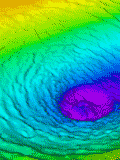 Abstract: Micropaleontological and nannopaleontological analyses have
been carried out on ditch cuttings samples from two wells (Arco British 43/24-3
and British Gas 43/25-1), which penetrated the 'Silverpit Crater' structure in
the Southern North Sea Basin (UK Sector). A stratigraphic gap (within the limits
of resolution imposed by sampling constraints) has been identified between
chalky limestones of Maastrichtian age, which are overlain by sediments of
latest Paleocene age or younger. Accepting an impact-origin for the structure,
the gap represents an impact-event, which occurred almost certainly post
Cretaceous and Early Paleocene times and thus probably within the Late
Paleocene, close to the Paleocene-Eocene boundary, ruling out an association with the K/P
extinction impact. In well 43/25-1 a short interval of mixed microfaunas and
nannofloras was observed, which is suggested as being related to 'resurgence
deposits' entering the crater immediately after the impact-event. Abstract: Micropaleontological and nannopaleontological analyses have
been carried out on ditch cuttings samples from two wells (Arco British 43/24-3
and British Gas 43/25-1), which penetrated the 'Silverpit Crater' structure in
the Southern North Sea Basin (UK Sector). A stratigraphic gap (within the limits
of resolution imposed by sampling constraints) has been identified between
chalky limestones of Maastrichtian age, which are overlain by sediments of
latest Paleocene age or younger. Accepting an impact-origin for the structure,
the gap represents an impact-event, which occurred almost certainly post
Cretaceous and Early Paleocene times and thus probably within the Late
Paleocene, close to the Paleocene-Eocene boundary, ruling out an association with the K/P
extinction impact. In well 43/25-1 a short interval of mixed microfaunas and
nannofloras was observed, which is suggested as being related to 'resurgence
deposits' entering the crater immediately after the impact-event.
|
|
Carnets Geol., vol. 25, no. 7, p. 155-167
Online since May 27, 2025
|
|
Symbiosis between bryozoans with erect cribrate colonies and rugose corals from the lower Katian (Upper Ordovician) of Estonia
Olev VINN, Andrej ERNST, Mark A. WILSON & Ursula TOOM
| HTML  | PDF
| PDF  [625 KB]
| DOI: 10.2110/carnets.2025.2506 [625 KB]
| DOI: 10.2110/carnets.2025.2506
|
|
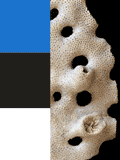 Abstract: Specimens of the rugose coral Streptelasma?
sp. are found intergrown with a host bryozoan Oanduellina
bella in the lower Katian of Estonia. Rugosa also occur in the bryozoan Proavella proava. This is the earliest and only
known record of endobiotic rugose symbionts in cryptostome bryozoans from the
Late Ordovician of Baltica. The erect bryozoan colonies provided symbiotic Rugosa with both a higher and more advantageous tier for feeding in the
water column and a hard substrate that these encrusting Rugosa required. The
rugose corals may have protected the bryozoans with their stinging cells against
predators. The lack of malformations in the bryozoan zooid architecture and
their normal dimensions around the Rugosa show that the relationship between
the Rugosa and bryozoans could have been mutualistic, which is similar to
many other Rugosa-bryozoan associations in the Late Ordovician of Baltica,
although the exact nature of this association remains uncertain. Abstract: Specimens of the rugose coral Streptelasma?
sp. are found intergrown with a host bryozoan Oanduellina
bella in the lower Katian of Estonia. Rugosa also occur in the bryozoan Proavella proava. This is the earliest and only
known record of endobiotic rugose symbionts in cryptostome bryozoans from the
Late Ordovician of Baltica. The erect bryozoan colonies provided symbiotic Rugosa with both a higher and more advantageous tier for feeding in the
water column and a hard substrate that these encrusting Rugosa required. The
rugose corals may have protected the bryozoans with their stinging cells against
predators. The lack of malformations in the bryozoan zooid architecture and
their normal dimensions around the Rugosa show that the relationship between
the Rugosa and bryozoans could have been mutualistic, which is similar to
many other Rugosa-bryozoan associations in the Late Ordovician of Baltica,
although the exact nature of this association remains uncertain.
|
|
Carnets Geol., vol. 25, no. 6, p. 147-154
Online since April 1, 2025
|
|
The Aptian-Albian of the Costa Blanca (SE Spain): Implications for identifying the Aptian/Albian boundary in the neritic zone within the Tethys realm
Bruno R.C. GRANIER, Emmanuel ROBERT & Joanaitz PÉREZ-MALO
| HTML  | PDF
| PDF  [7,771 KB]
| DOI: 10.2110/carnets.2025.2505
[7,771 KB]
| DOI: 10.2110/carnets.2025.2505
|
|
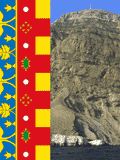 Abstract: The
Aptian-Albian interval of the Costa Blanca (SE Spain) has been
studied to provide new insights into the evolution of the neritic domain of
carbonate platforms in the Tethys. Three areas have been re-examined: Serra
Gelada, Puig Campana, and Cabeçó d'Or. The biozonations of large benthic
foraminifers (LBF) have been revised based on ammonite biostratigraphy. Updated
ammonite datings and stratigraphic revisions reveal that several LBF and
calcareous algae (CA) taxa previously attributed to the late Aptian actually
originated in the early Albian. These findings correct and refine the
calibration of LBF and CA biozones and ranges with standard ammonite zones.
Furthermore, the identification of a significant local hiatus during the middle
Albian at Cabeçó d'Or is likely linked to halokinesis. Abstract: The
Aptian-Albian interval of the Costa Blanca (SE Spain) has been
studied to provide new insights into the evolution of the neritic domain of
carbonate platforms in the Tethys. Three areas have been re-examined: Serra
Gelada, Puig Campana, and Cabeçó d'Or. The biozonations of large benthic
foraminifers (LBF) have been revised based on ammonite biostratigraphy. Updated
ammonite datings and stratigraphic revisions reveal that several LBF and
calcareous algae (CA) taxa previously attributed to the late Aptian actually
originated in the early Albian. These findings correct and refine the
calibration of LBF and CA biozones and ranges with standard ammonite zones.
Furthermore, the identification of a significant local hiatus during the middle
Albian at Cabeçó d'Or is likely linked to halokinesis.
|
|
Carnets Geol., vol. 25, no. 5, p. 109-145
Online since February 15, 2025
|
|
Calcareous green algae (Dasycladales, Halimedaceae) from the Upper Cretaceous of the western Tarim Basin, NW China: Systematic palaeontology, microfacies, and palaeobiogeographic significance
Felix SCHLAGINTWEIT, Yiwei XU & Shijie ZHANG
| HTML  | PDF
| PDF  [4,161 KB]
| DOI: 10.2110/carnets.2025.2504
[4,161 KB]
| DOI: 10.2110/carnets.2025.2504
|
|
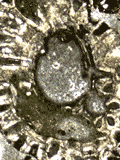 Abstract: Few stratigraphical and micropalaeontological data are available from
Upper Cretaceous shallow-water marine carbonates of the southwestern Tarim
Basin, western China. The present study provides new data about the microfauna
and calcareous algae of the Cenomanian-Turonian Kukebai Formation and the
Campanian Yigeziya Formation. The investigated bioclastic carbonates yield a
rather poorly diversified microfauna (benthic foraminifers) contrasting with a
relatively well diversified assemblage of dasycladalean green algae comprising
16 taxa. For several taxa, the available material does only allow for an open
taxonomic treatment. A new species is described herein as Morelletpora sinica. These
calcareous algae are supplemented by debris of halimedacean algae (Arabicodium?
sp.). Occurrences of calcareous algae and larger benthic foraminifers in
Cenomanian and Campanian carbonates coincide with two major transgressions
reported from the Tarim Basin. The observed faunal and phycological elements
indicate a direct connection between the Neotethys and the Tarim epicontinental
sea. The lack of several typical Cenomanian (e.g., alveolinoids,
orbitolinids) and Campanian larger benthic foraminifers in the studied material
is striking. Abstract: Few stratigraphical and micropalaeontological data are available from
Upper Cretaceous shallow-water marine carbonates of the southwestern Tarim
Basin, western China. The present study provides new data about the microfauna
and calcareous algae of the Cenomanian-Turonian Kukebai Formation and the
Campanian Yigeziya Formation. The investigated bioclastic carbonates yield a
rather poorly diversified microfauna (benthic foraminifers) contrasting with a
relatively well diversified assemblage of dasycladalean green algae comprising
16 taxa. For several taxa, the available material does only allow for an open
taxonomic treatment. A new species is described herein as Morelletpora sinica. These
calcareous algae are supplemented by debris of halimedacean algae (Arabicodium?
sp.). Occurrences of calcareous algae and larger benthic foraminifers in
Cenomanian and Campanian carbonates coincide with two major transgressions
reported from the Tarim Basin. The observed faunal and phycological elements
indicate a direct connection between the Neotethys and the Tarim epicontinental
sea. The lack of several typical Cenomanian (e.g., alveolinoids,
orbitolinids) and Campanian larger benthic foraminifers in the studied material
is striking.
|
|
Carnets Geol., vol. 25, no. 4, p. 89-108
Online since Febuary 3, 2025
|
|
Itierella melognensis n.gen., n.sp., and Paradicostella hautevillelompnesensis n.gen., n.sp. (Ammonoidea, Neocomitidae, Neocomitinae), two new upper Valanginian trituberculated ammonoids from the Jura Mountains, eastern France
Antoine PICTET, Bruno HUGON & Gustavo PIERANGELINI
| HTML  | PDF
| PDF  [1,987 KB]
| DOI: 10.2110/carnets.2025.2503
[1,987 KB]
| DOI: 10.2110/carnets.2025.2503
|
|
 Abstract: Several
ammonoid specimens from the upper Valanginian (Lower Cretaceous) sedimentary
succession of Hauteville-Lompnes, Department of Ain, eastern France, are
assigned to the new genera and species Itierella melognensis n.gen.,
n.sp., and Paradicostella hautevillelompnesensis n.gen., n.sp. Specimens
collected in the past were misidentified as Acanthodiscus Uhlig,
1905, and erroneously assigned to the lowermost part of the Hauterivian stage.
The revision of the Marnes de Mélogne,
along with the collection of a rich associated ammonite fauna, allows Itierella
to be recognized as a latest Valanginian homeomorphic form of the
genus Acanthodiscus,
and Paradicostella as closely related to the genus Dicostella
Busnardo, 1966. The Marnes de Mélogne
are revised as mostly belonging to the upper Saynoceras verrucosum to Criosarasinella
furcillata ammonite zones (uppermost Valanginian), while their uppermost
metre is assigned to the Acanthodiscus
radiatus Zone (lowermost Hauterivian). Abstract: Several
ammonoid specimens from the upper Valanginian (Lower Cretaceous) sedimentary
succession of Hauteville-Lompnes, Department of Ain, eastern France, are
assigned to the new genera and species Itierella melognensis n.gen.,
n.sp., and Paradicostella hautevillelompnesensis n.gen., n.sp. Specimens
collected in the past were misidentified as Acanthodiscus Uhlig,
1905, and erroneously assigned to the lowermost part of the Hauterivian stage.
The revision of the Marnes de Mélogne,
along with the collection of a rich associated ammonite fauna, allows Itierella
to be recognized as a latest Valanginian homeomorphic form of the
genus Acanthodiscus,
and Paradicostella as closely related to the genus Dicostella
Busnardo, 1966. The Marnes de Mélogne
are revised as mostly belonging to the upper Saynoceras verrucosum to Criosarasinella
furcillata ammonite zones (uppermost Valanginian), while their uppermost
metre is assigned to the Acanthodiscus
radiatus Zone (lowermost Hauterivian).
|
|
Carnets Geol., vol. 25, no. 3, p. 73-87
Online since January 15, 2025
|
|
Nomenclatural Note, p.
88
|
|
Rectifying a substantial biostratigraphic error: There are no Hauterivian calpionellids in Busot (Alicante, Spain)
Bruno R.C. GRANIER, José Miguel ANDREU RODES, Mohamed BENZAGGAGH, Joachim BLAU, Éric BÖKER, Antonio ESTÉVEZ RUBIO, Bruno FERRÉ, Bernard C. LAMBERT, Agostino MARINI, Eric MONTEIL, Stéphane REBOULET & Aurélien VIRGONE
| HTML  | PDF
| PDF  [7,887 KB]
| DOI: 10.2110/carnets.2025.2502 [7,887 KB]
| DOI: 10.2110/carnets.2025.2502
|
|
 Abstract: Earlier
misidentifications of ammonites from Busot (SE Spain) led to two incorrect
hypotheses regarding calpionellids, which are today attributed to the Calpionellopsis
Zone (D) of the upper Berriasian. The first
hypothesis suggested that some calpionellid species survived into Hauterivian
times, while the second hypothesis proposed that these calpionellids were
reworked into Hauterivian strata. However, the revision of the ammonitic
material collected in 1993-1994, along with the study of new material collected
in 2024, suggests a late Berriasian age, as the ammonite assemblages likely correspond
to the Fauriella boissieri and Tirnovella alpillensis Standard Ammonites zones.
Nannofossil assemblages and the presence of Octahedronoides tethysianus
further support this dating. This reassessment calls for a reexamination of
claims regarding the occurrence of calpionellids in strata younger than the
Valanginian in the literature. Abstract: Earlier
misidentifications of ammonites from Busot (SE Spain) led to two incorrect
hypotheses regarding calpionellids, which are today attributed to the Calpionellopsis
Zone (D) of the upper Berriasian. The first
hypothesis suggested that some calpionellid species survived into Hauterivian
times, while the second hypothesis proposed that these calpionellids were
reworked into Hauterivian strata. However, the revision of the ammonitic
material collected in 1993-1994, along with the study of new material collected
in 2024, suggests a late Berriasian age, as the ammonite assemblages likely correspond
to the Fauriella boissieri and Tirnovella alpillensis Standard Ammonites zones.
Nannofossil assemblages and the presence of Octahedronoides tethysianus
further support this dating. This reassessment calls for a reexamination of
claims regarding the occurrence of calpionellids in strata younger than the
Valanginian in the literature.
|
|
Carnets Geol., vol. 25, no. 2, p. 29-72
Online since December 25, 2024
|
|
Aragonite neomorphism via intrafabric dissolution and calcite precipitation, not thin films
Arthur SALLER
| HTML  | PDF
| PDF  [7,408 KB]
| DOI: 10.2110/carnets.2025.2501 [7,408 KB]
| DOI: 10.2110/carnets.2025.2501
|
|
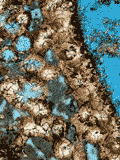 Abstract: Since the
1970's, aragonite neomorphism (conversion of aragonite to calcite with partial
retention of original internal structure) has been attributed to thin diagenetic
films, often in meteoric water. Pleistocene material from Enewetak, the Bahamas
and eastern Yucatan show the transition from aragonite to calcite "in progress".
Original aragonitic material includes coral, Halimeda, molluscs (especially
gastropods) and ooids. In all three areas, aragonite commonly shows partial
intrafabric dissolution. In many cases, calcite crystals grew over that highly
microporous aragonite to create calcite with partial retention of the original
depositional fabric, creating neomorphosed (calcitized) aragonite. Geochemical data support
this scenario. Carbon and oxygen isotopic compositions of the neomorphic
calcites are similar to sparry meteoric calcite cements indicating crystals
precipitated from similar waters as the cements. Stable carbon isotopes and Mg
concentrations in neomorphic calcites are different from their aragonitic
precursors and are not consistent with the thin-film model, which assumes a
semi-closed system. Approximately 40 of the 95 Pleistocene Enewetak samples have
aragonite with intrafabric dissolution adjacent to calcitized (neomorphic)
aragonite. Neomorphosed (calcitized) aragonite was not observed immediately
adjacent to unaltered aragonite (i.e., separated by what would have been a thin film) in any Enewetak
samples. This supports aragonite neomorphism by a two-stage process (intrafabric
dissolution followed by calcite precipitation) rather than by thin films.
Variations in concentration of inclusions in neomorphosed aragonite are similar
to variations of relict material in aragonite with partial intrafabric
dissolution and span a continuum from abundant aragonitic inclusions in
neomorphic spar to inclusion-free calcite cement. Abstract: Since the
1970's, aragonite neomorphism (conversion of aragonite to calcite with partial
retention of original internal structure) has been attributed to thin diagenetic
films, often in meteoric water. Pleistocene material from Enewetak, the Bahamas
and eastern Yucatan show the transition from aragonite to calcite "in progress".
Original aragonitic material includes coral, Halimeda, molluscs (especially
gastropods) and ooids. In all three areas, aragonite commonly shows partial
intrafabric dissolution. In many cases, calcite crystals grew over that highly
microporous aragonite to create calcite with partial retention of the original
depositional fabric, creating neomorphosed (calcitized) aragonite. Geochemical data support
this scenario. Carbon and oxygen isotopic compositions of the neomorphic
calcites are similar to sparry meteoric calcite cements indicating crystals
precipitated from similar waters as the cements. Stable carbon isotopes and Mg
concentrations in neomorphic calcites are different from their aragonitic
precursors and are not consistent with the thin-film model, which assumes a
semi-closed system. Approximately 40 of the 95 Pleistocene Enewetak samples have
aragonite with intrafabric dissolution adjacent to calcitized (neomorphic)
aragonite. Neomorphosed (calcitized) aragonite was not observed immediately
adjacent to unaltered aragonite (i.e., separated by what would have been a thin film) in any Enewetak
samples. This supports aragonite neomorphism by a two-stage process (intrafabric
dissolution followed by calcite precipitation) rather than by thin films.
Variations in concentration of inclusions in neomorphosed aragonite are similar
to variations of relict material in aragonite with partial intrafabric
dissolution and span a continuum from abundant aragonitic inclusions in
neomorphic spar to inclusion-free calcite cement.
|
|
Carnets Geol., vol. 25, no. 1, p. 1-28
Online since December 20, 2024
|
|
|
|